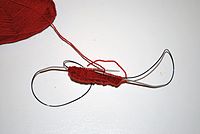




Circular knitting or knitting in the round is a form of knitting that creates a seamless tube. Work in the round is begun by casting on stitches as for flat knitting but then joining the ends of that row of stitches to form a circle. Knitting is worked in rounds (the equivalent of the rows in flat knitting), which forms the tube by winding around in a helix.[1]
Originally, circular knitting was done using a set of four or five double-pointed needles. Today, knitters often use instead a circular needle, which resembles a pair of short knitting needles connected by a cable between them. Circular knitting can also be performed by knitting machines: a double-bed machine can be set up to knit on its front bed in one direction and then its back bed on the return, which creates the tube.[2][3] Specialized knitting machines for sock-knitting use individual latch-hook needles to make each stitch in a round frame.[4]
Many types of sweaters are traditionally knit in the round. Planned openings (arm holes, necks, cardigan fronts) are temporarily knitted with extra stitches, reinforced if necessary. Then the extra stitches are cut to create the opening, and are stitched with a sewing machine to prevent unraveling.[5] This technique is called steeking.
- ^ "Circular needles". knitty.com.
- ^ "Flat knitting machine having four opposed needle beds - Patent # 4100766 - PatentGenius". Archived from the original on 2007-09-27. Retrieved 2007-09-03.
- ^ "Circular knitting machine - Patent # 3969912 - PatentGenius". Archived from the original on 2017-01-01. Retrieved 2017-01-01.
- ^ "Sock Machine Museum Sock Knitting Machine Information, Sales, Patterns and Museum". www.oldtymestockings.com.
- ^ "KidsKnits - Steeks Introduction". Archived from the original on 2016-02-24. Retrieved 2007-09-03.